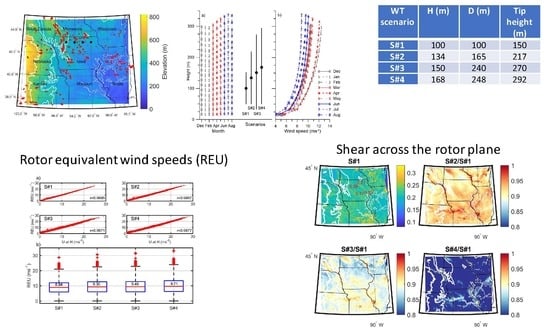Power and Wind Shear Implications of Large Wind Turbine Scenarios in the US Central Plains
Abstract
1. Introduction
2. Methods
2.1. WRF Model Simulations
2.2. WRF Model Domains and Transect
2.3. WRF Model Layers and Height
2.4. WT Scenarios
2.5. Rotor Equivalent Wind Speed
2.6. Power
2.7. Shear across the Rotor Plane
3. Results
3.1. Wind Speed Profiles and REU
3.2. Power Ratios
3.3. Shear across the Rotor Plane
4. Discussion and Concluding Remarks
Author Contributions
Funding
Acknowledgments
Conflicts of Interest
References
- WindEurope. Wind Energy in Europe Trends and Statistics 2019. p. 24. Available online: https://windeurope.org/wp-content/uploads/files/about-wind/statistics/WindEurope-Annual-Statistics-2019.pdf (accessed on 27 February 2020).
- WindEurope. Offshore Wind in Europe Key Trends and Statistics 2019. p. 40. Available online: https://windeurope.org/wp-content/uploads/files/about-wind/statistics/WindEurope-Annual-Offshore-Statistics-2019.pdf (accessed on 27 February 2020).
- Hand, M.M. (Ed.) IEA Wind TCP Task 26‒Wind Technology, Cost, and Performance Trends in Denmark, Germany, Ireland, Norway, Sweden, the European Union, and the United States: 2008‒2016; NREL/TP-6A20.71844; National Renewable Energy Laboratory: Golden, CO, USA, 2008; p. 104. Available online: https://www.nrel.gov/docs/fy19osti/71844.pdf (accessed on 13 July 2020).
- Wiser, R.; Bolinger, M. 2018 Wind Technologies Market Report; DOE/GO-102019-5191; U.S. Department of Energy, Office of Energy Efficiency and Renewable Energy: Oak Ridge, TN, USA, 2018; p. 103. Available online: https://www.energy.gov/eere/wind/downloads/2018-wind-technologies-market-report (accessed on 13 August 2020).
- Bolinger, M.; Lantz, E.; Wiser, R.; Hoen, B.; Rand, J.; Hammond, R. Opportunities for and challenges to further reductions in the “specific power” rating of wind turbines installed in the United States. Wind Eng. 2020. [Google Scholar] [CrossRef]
- IRENA. Future of Wind Deployment, Investment, Technology, Grid Integration and Socio-Economic Aspects; International Renewable Energy Agency: Abu Dhabi, UAE, 2019; p. 88. ISBN 978-92-9260-155-3. [Google Scholar]
- WindEurope. Wind Energy in Europe: Outlook to 2023. 2019, p. 40. Available online: https://www.anev.org/wp-content/uploads/2019/10/Market-outlook-2019.pdf (accessed on 13 August 2020).
- Beiter, P.; Musial, W.; Kilcher, L.; Maness, M.; Smith, A. An Assessment of the Economic Potential of Offshore Wind in the United States from 2015 to 2030; Technical Report: NREL/TP-6A20-67675; National Renewable Energy Laboratory: Golden, CO, USA, 2017; p. 77.
- Preindl, M.; Bolognani, S. Optimization of the generator to rotor ratio of mw wind turbines based on the cost of energy with focus on low wind speeds. In Proceedings of the IECON 2011 37th Annual Conference of the IEEE Industrial Electronics Society, Victoria, Australia, 7–10 November 2011; pp. 906–911. [Google Scholar]
- Wiser, R.; Millstein, D.; Bolinger, M.; Jeong, S.; Mills, A. The hidden value of large-rotor, tall-tower wind turbines in the United States. Wind Eng. 2020. [Google Scholar] [CrossRef]
- Lantz, E.; Roberts, O.; Nunemaker, J.; DeMeo, O.; Dykes, K.; Scott, G. Increasing Wind Turbine Tower Heights: Opportunities and Challenges; NREL/TP-5000-73629; National Renewable Energy Laboratory: Golden, CO, USA, 2019; p. 66.
- Musial, W.; Beiter, J.; Spitsen, P.; Nunemaker, J.; Gevorgian, V. 2018 Offshore Wind Technologies Market Report; Department of Energy: Oak Ridge, TN, USA, 2019; p. 94. [Google Scholar]
- AWEA. Wind Powers America. 2019 Annual Report; American Wind Energy Association: Washington, WA, USA, 2020; p. 138. [Google Scholar]
- AWEA. AWEA Wind IQ. Available online: https://windiq.awea.org/app/ (accessed on 26 May 2020).
- IEA. Offshore Wind Outlook; IEA: Paris, France, 2019; p. 98. [Google Scholar]
- Stull, R.B. An Introduction to Boundary Layer Meteorology; Kluwer Publications Ltd.: Dordrecht, The Netherlands, 1988; p. 666. ISBN 90-277-2768-6. [Google Scholar]
- Foken, T. 50 years of the Monin–Obukhov similarity theory. Bound. Layer Meteorol. 2006, 119, 431–447. [Google Scholar] [CrossRef]
- Motta, M.; Barthelmie, R.J.; Vølund, P. The influence of non-logarithmic wind speed profiles on potential power output at Danish offshore sites. Wind Energy 2005, 8, 219–236. [Google Scholar] [CrossRef]
- Irwin, J.S. A theoretical variation of the wind profile power-law exponent as a function of surface roughness and stability. Atmos. Environ. 1979, 13, 191–194. [Google Scholar]
- International Electrotechnical Commission. International Standard, IEC61400 Wind Turbines Wind Energy Generation Systems–Part 1: Design Requirements, Edition 4.0 2019-02; IEC, FDIS: Geneva, Switzerland, 2019; p. 172. [Google Scholar]
- Drechsel, S.; Mayr, G.J.; Messner, J.W.; Stauffer, R. Wind Speeds at Heights Crucial for Wind Energy: Measurements and Verification of Forecasts. J. Appl. Meteorol. Climatol. 2012, 51, 1602–1617. [Google Scholar] [CrossRef]
- Schwartz, M.; Elliott, D. Wind Shear Characteristics at Central Plains Tall Towers; NREL/CP-500-40019; National Renewable Energy Laboratory: Golden, CO, USA, 2006; p. 10.
- Walton, R.A.; Takle, E.S.; Gallus, W.A. Characeristics of 50-200m winds and temperatures derived from an Iowa tall-tower network. J. Appl. Meteorol. Climatol. 2014, 53, 2387–2393. [Google Scholar] [CrossRef]
- Gryning, S.E.; Batchvarova, E.; Brümmer, B.; Jørgensen, H.E.; Larsen, S.E. On the extension of the wind profile over homogeneous terrain beyond the surface boundary layer. Bound. Layer Meteorol. 2007, 124, 251–268. [Google Scholar]
- Peña, A.; Gryning, S.E.; Mann, J. On the length-scale of the wind profile. Q. J. R. Meteorol. Soc. 2010, 136, 2119–2131. [Google Scholar] [CrossRef]
- Sathe, A.; Gryning, S.-E.; Peña, A. Comparison of the atmospheric stability and wind profiles at two wind farm sites over a long marine fetch in the North Sea. Wind Energy 2011, 14, 767–780. [Google Scholar] [CrossRef]
- Shapiro, A.; Fedorovich, E. Analytical description of a nocturnal low-level jet. Q. J. R. Meteorol. Soc. 2010, 136, 1255–1262. [Google Scholar] [CrossRef]
- Storm, B.; Basu, S. The WRF model forecast-derived low-level wind shear climatology over the United States Great Plains. Energies 2010, 3, 258–276. [Google Scholar] [CrossRef]
- Nikolic, J.; Zhong, S.; Pei, L.; Bian, X.; Heilman, J.; Charney, J.J. Sensitivity of Low-Level Jets to Land-Use and Land-Cover Change over the Continental U.S. Atmosphere 2019, 10, 174. [Google Scholar] [CrossRef]
- Storm, B.; Dudhia, J.; Basu, S.; Swift, A.; Giammanco, I. Evaluation of the Weather Research and Forecasting model on forecasting low-level jets: Implications for wind energy. Wind Energy 2009, 12, 81–90. [Google Scholar] [CrossRef]
- Aird, J.A.; Barthelmie, R.J.; Shepherd, T.J.; Pryor, S.C. WRF-Simulated springtime low-level jets over Iowa: Implications for Wind Energy. J. Phys. Conf. Ser. Sci. Mak. Torque Wind. 2020, in press. [Google Scholar]
- Gutierrez, W.; Ruiz-Columbie, A.; Tutkun, M.; Castillo, L. Impacts of the low-level jet’s negative wind shear on the wind turbine. Wind Energ. Sci. 2017, 2, 533–545. [Google Scholar] [CrossRef]
- Robertson, A.N.; Shaler, K.; Sethuraman, L.; Jonkman, J. Sensitivity analysis of the effect of wind characteristics and turbine properties on wind turbine loads. Wind Energ. Sci. 2019, 4, 479–513. [Google Scholar] [CrossRef]
- Park, J.; Basu, S.; Manuel, L. Large-eddy simulation of stable boundary layer turbulence and estimation of associated wind turbine loads. Wind Energy 2014, 17, 359–384. [Google Scholar] [CrossRef]
- Smith, K.; Randall, G.; Malcolm, D. Evaluation of Wind Shear Patterns at Midwest Wind Energy Facilities; NREL: Golden, CO, USA, 2002; p. 20. Available online: https://www.nrel.gov/docs/fy02osti/32492.pdf (accessed on 13 August 2020).
- Barthelmie, R.J.; Shepherd, T.J.; Pryor, S.C. Increasing turbine dimensions: Impact on shear and power. J. Phys. Conf. Ser. Sci. Mak. Torque Wind. 2020, 2020, 10. [Google Scholar]
- Rand, J.T.; Kramer, L.A.; Garrity, C.P.; Hoen, B.D.; Diffendorfer, J.E.; Hunt, H.E.; Spears, M. A continuously updated, geospatially rectified database of utility-scale wind turbines in the United States. Sci. Data 2020, 7, 1–12. [Google Scholar] [CrossRef]
- Gaertner, E.; Rinker, J.; Sethuraman, L.; Zahle, Z.; Anderson, B.; Barter, G.; Abbas, B.; Meng, F.; Bortolotti, F.; Skrzypinski, W.; et al. Definition of the IEA 15-Megawatt Offshore Reference Wind; NREL/TP-5000-75698; National Renewable Energy Laboratory: Golden, CO, USA, 2020. Available online: https://www.nrel.gov/docs/fy20osti/75698.pdf (accessed on 13 August 2020).
- Mann, J.; Angelou, N.; Arnqvist, J.; Callies, D.; Cantero, E.; Arroyo, R.C.; Courtney, M.; Cuxart, J.; Dellwik, E.; Gottschall, J.; et al. Complex terrain experiments in the New European Wind Atlas. Philos. Trans. R. Soc. A Math. Phys. Eng. Sci. 2017, 375. [Google Scholar] [CrossRef] [PubMed]
- Wilczak, J.M.; Olson, J.B.; Djalalova, I.; Bianco, L.; Berg, L.K.; Shaw, W.J.; Coulter, R.L.; Eckman, R.M.; Freedman, J.; Finley, C.; et al. Data assimilation impact of in situ and remote sensing meteorological observations on wind power forecasts during the first Wind Forecast Improvement Project (WFIP). Wind Energy 2019, 22, 932–944. [Google Scholar] [CrossRef]
- Letson, F.; Barthelmie, R.J.; Hu, W.; Pryor, S.C. Characterizing wind gusts in complex terrain. Atmos. Chem. Phys. 2019, 19, 3797–3819. [Google Scholar] [CrossRef]
- Barthelmie, R.J.; Pryor, S.C. Automated wind turbine wake characterization in complex terrain. Atmos. Meas. Tech. 2019, 12, 3463–3484. [Google Scholar] [CrossRef]
- Guggeri, A.; Draper, M. Large Eddy Simulation of an Onshore Wind Farm with the Actuator Line Model Including Wind Turbine’s Control below and above Rated Wind Speed. Energies 2019, 12, 3508. [Google Scholar] [CrossRef]
- Cheng, W.Y.; Liu, Y.; Bourgeois, A.J.; Wu, Y.; Haupt, S.E. Short-term wind forecast of a data assimilation/weather forecasting system with wind turbine anemometer measurement assimilation. Renew. Energy 2017, 107, 340–351. [Google Scholar] [CrossRef]
- Hahmann, A.N.; Sıle, T.; Witha, B.; Davis, N.N.; Dörenkämper, M.; Ezber, Y.; García-Bustamante, E.; González-Rouco, J.F.; Navarro, J.; Olsen, B.T. The making of the New European Wind Atlas, Part 1: Model sensitivity. Geosci. Model Dev. Discuss. 2020. in review. Available online: https://doi.org/10.5194/gmd-2019-349 (accessed on 13 August 2020).
- Hahmann, A.N.; Vincent, C.L.; Peña, A.; Lange, J.; Hasager, C.B. Wind climate estimation using WRF model output: Method and model sensitivities over the sea. Int. J. Climatol. 2015, 35, 3422–3439. [Google Scholar] [CrossRef]
- Pryor, S.C.; Shepherd, T.J.; Volker, P.J.; Hahmann, A.N.; Barthelmie, R.J. ‘Wind theft’ from onshore arrays: Sensitivity to wind farm parameterization and resolution. J. Appl. Meteorol. Climatol. 2020, 59, 153–174. [Google Scholar] [CrossRef]
- Pryor, S.C.; Shepherd, T.J.; Volker, P.J.H.; Hahmann, A.N.; Barthelmie, R.J. Diagnosing systematic differences in predicted wind turbine array-array interactions. J. Phys. Conf. Ser. Sci. Mak. Torque Wind 2020, in press. [Google Scholar]
- Pryor, S.C.; Shepherd, T.J.; Barthelmie, R.J.; Hahmann, A.N.; Volker, P.J.H. Wind farm wakes simulated using WRF. J. Phys. Conf. Ser. 2019, 1256, 012025. [Google Scholar]
- Vestas. EnVentus™ V150-5.6 MW™ IEC S. Available online: https://www.vestas.com/en/products/enventus_platform/v150%205_6_mw#!grid_0_content_6_Container (accessed on 20 May 2020).
- Wind Energy Update. Siemens Gamesa to Deploy 14 MW Offshore Turbines by 2024. Available online: https://analysis.newenergyupdate.com/wind-energy-update/siemens-gamesa-unveils-giant-14-mw-turbine-new-england-study-favors-shared?utm_campaign=NEP%20WIN%2020MAY20%20Newsletter%20B&utm_medium=email&utm_source=Eloqua&elqTrackId=afe60f99cc1f473f9504c76c66ed4570&elq=ad7880b7461f4aa68b5fe4d257986140&elqaid=53488&elqat=1&elqCampaignId=34426 (accessed on 20 May 2020).
- Wagner, R.; Cañadillas, B.; Clifton, A.; Feeney, S.; Nygaard, N.; Poodt, M.; St. Martin, C.; Tüxen, E.; Wagenaar, J.W. Rotor equivalent wind speed for power curve measurement-comparative exercise for IEA Wind Annex 32. J. Phys. Conf. Ser. 2014, 524, 012108. [Google Scholar] [CrossRef]
- Van Sark, W.; Van der Velde, H.C.; Coelingh, J.P.; Bierbooms, W. Do we really need rotor equivalent wind speed? Wind Energy 2019, 22, 745–763. [Google Scholar] [CrossRef]
- Shepherd, T.J.; Barthelmie, R.J.; Pryor, S.C. Sensitivity of wind turbine array downstream effects to the parameterization used in WRF. J. Appl. Meteorol. Climatol. 2020, 59, 333–361. [Google Scholar] [CrossRef]
- Wharton, S.; Simpson, M.; Osuna, J.L.; Newman, J.F.; Biraud, S.C. Role of Surface Energy Exchange for Simulating Wind Turbine Inflow: A Case Study in the Southern Great Plains, USA. Atmosphere 2015, 6, 21–49. [Google Scholar] [CrossRef]
- Enevoldsen, P.; Sovacool, B.K. Examining the social acceptance of wind energy: Practical guidelines for onshore wind project development in France. Renew. Sustain. Energy Rev. 2016, 53, 178–184. [Google Scholar] [CrossRef]
- Meyerhoff, J.; Ohl, C.; Hartje, V. Landscape externalities from onshore wind power. Energy Policy 2010, 38, 82–92. [Google Scholar] [CrossRef]
- McKenna, R.; vd Leye, P.O.; Fichtner, W. Key challenges and prospects for large wind turbines. Renew. Sustain. Energy Rev. 2016, 53, 1212–1221. [Google Scholar] [CrossRef]
- Haupt, S.E.; Kosovic, B.; Shaw, W.; Berg, L.K.; Churchfield, M.; Cline, J.; Draxl, C.; Ennis, B.; Koo, E.; Kotamarthi, R. On bridging a modeling scale gap: Mesoscale to microscale coupling for wind energy. Bull. Am. Meteorol. Soc. 2019, 100, 2533–2550. [Google Scholar] [CrossRef]
- Mirocha, J.D.; Churchfield, M.J.; Muñoz-Esparza, D.; Rai, R.K.; Feng, Y.; Kosović, B.; Haupt, S.E.; Brown, B.; Ennis, B.L.; Draxl, C.; et al. Large-eddy simulation sensitivities to variations of configuration and forcing parameters in canonical boundary-layer flows for wind energy applications. Wind Energ. Sci. 2018, 3, 589–613. [Google Scholar] [CrossRef]
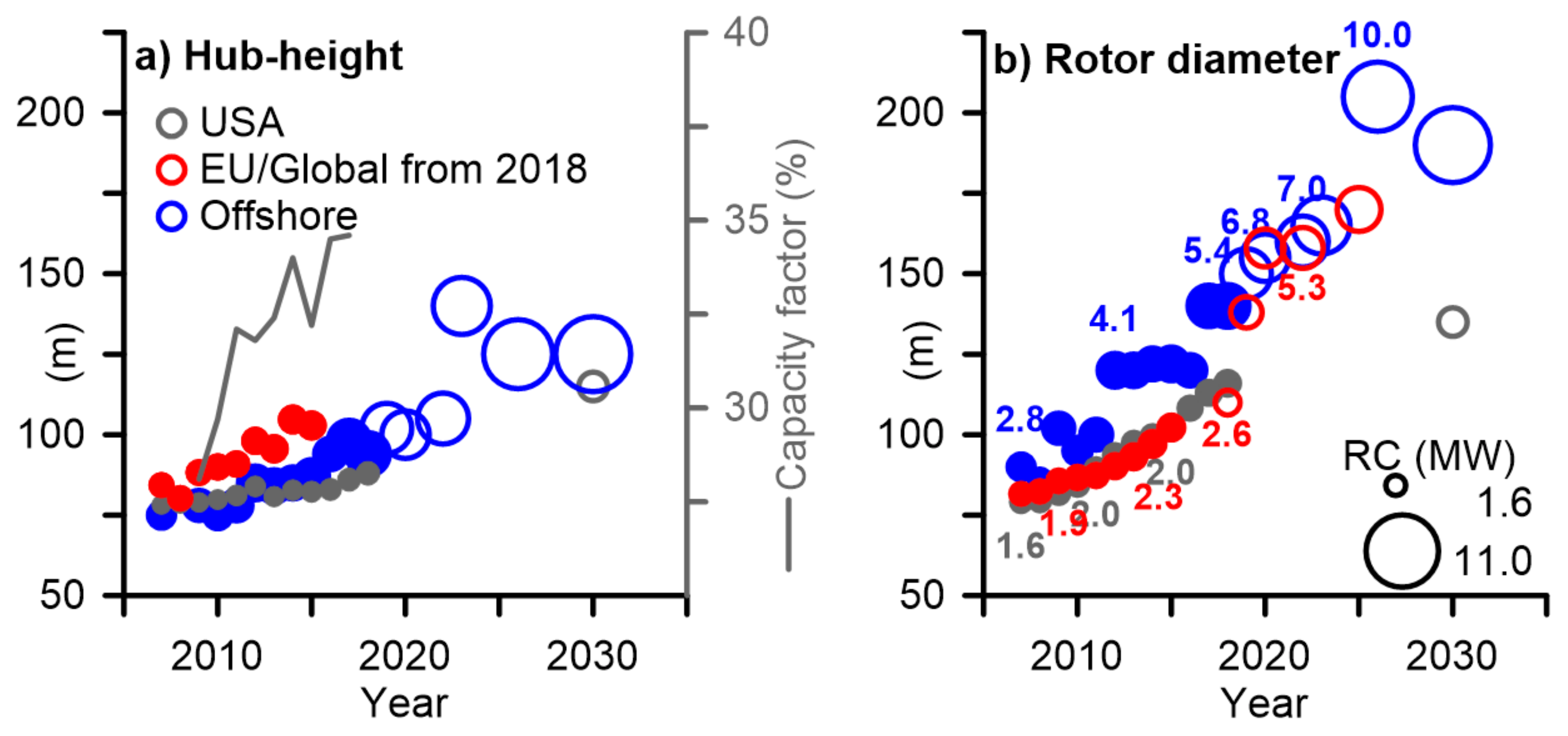
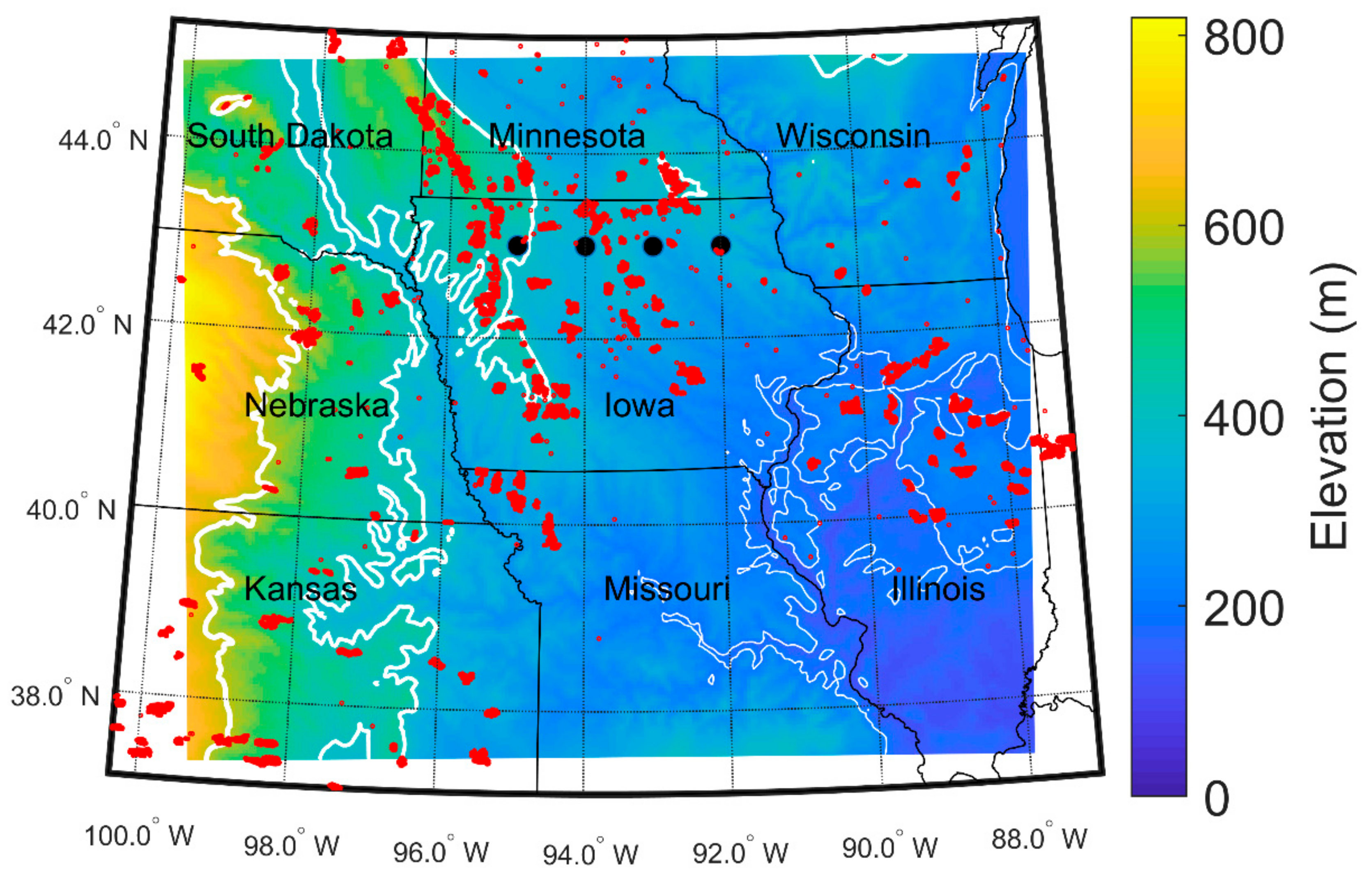

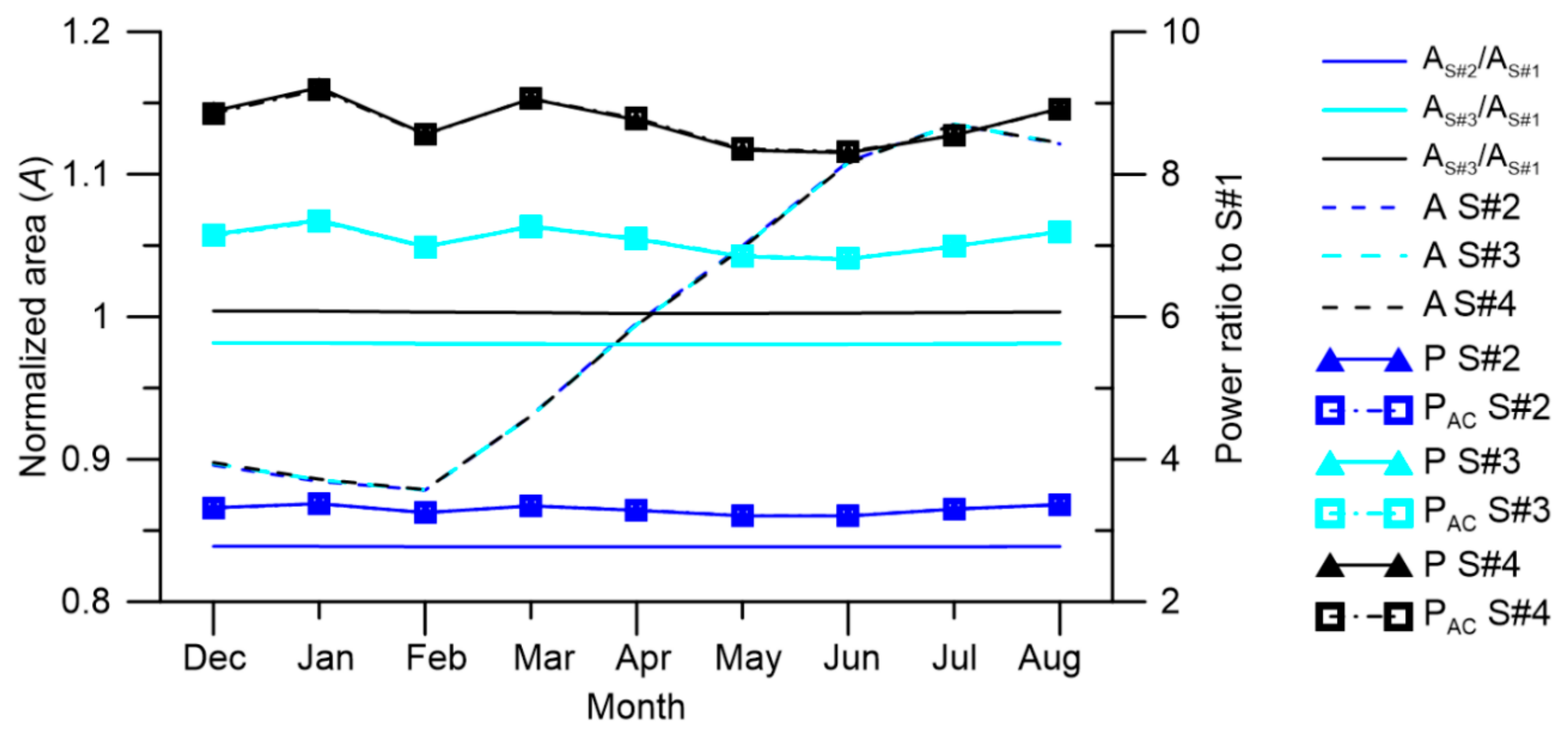
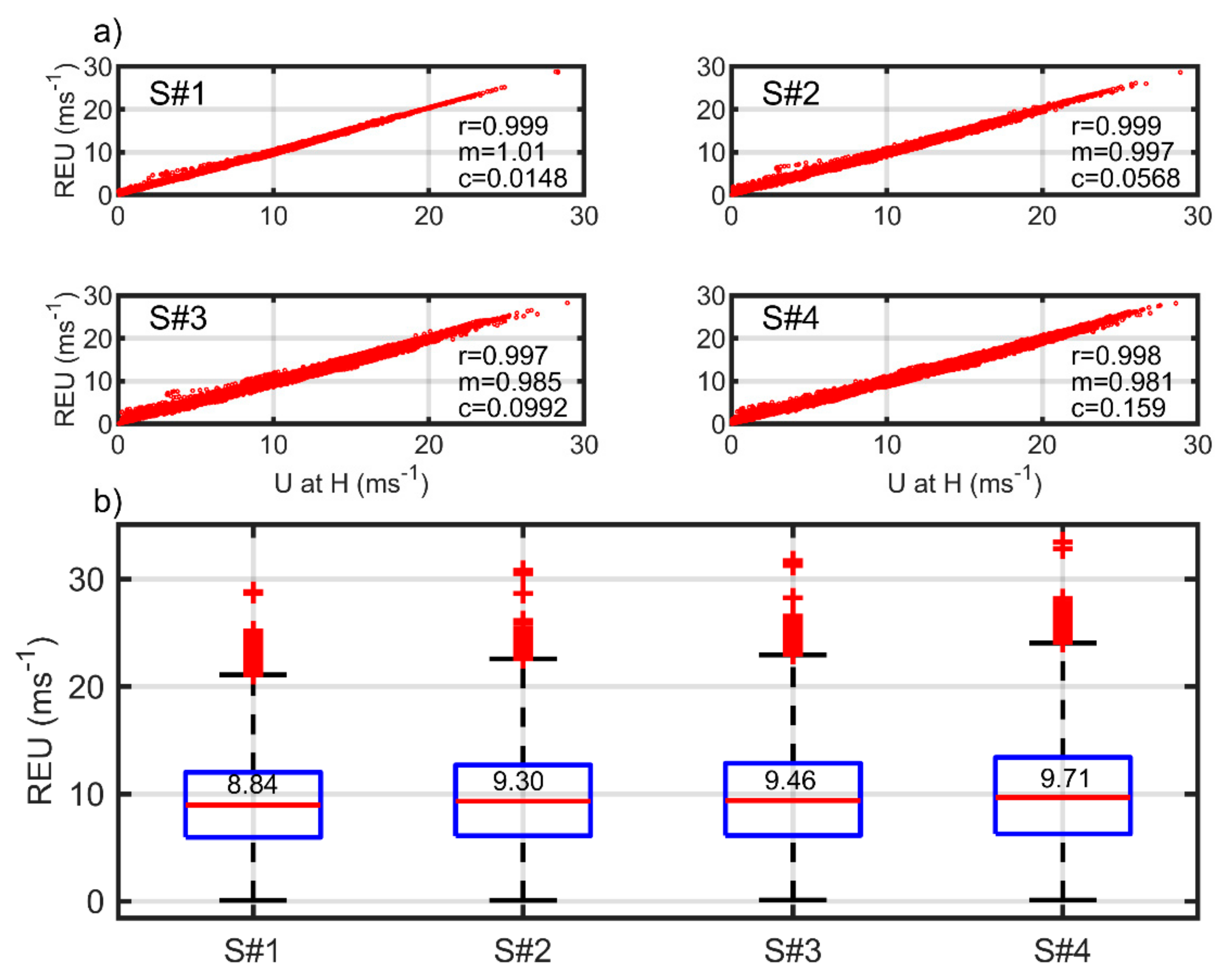
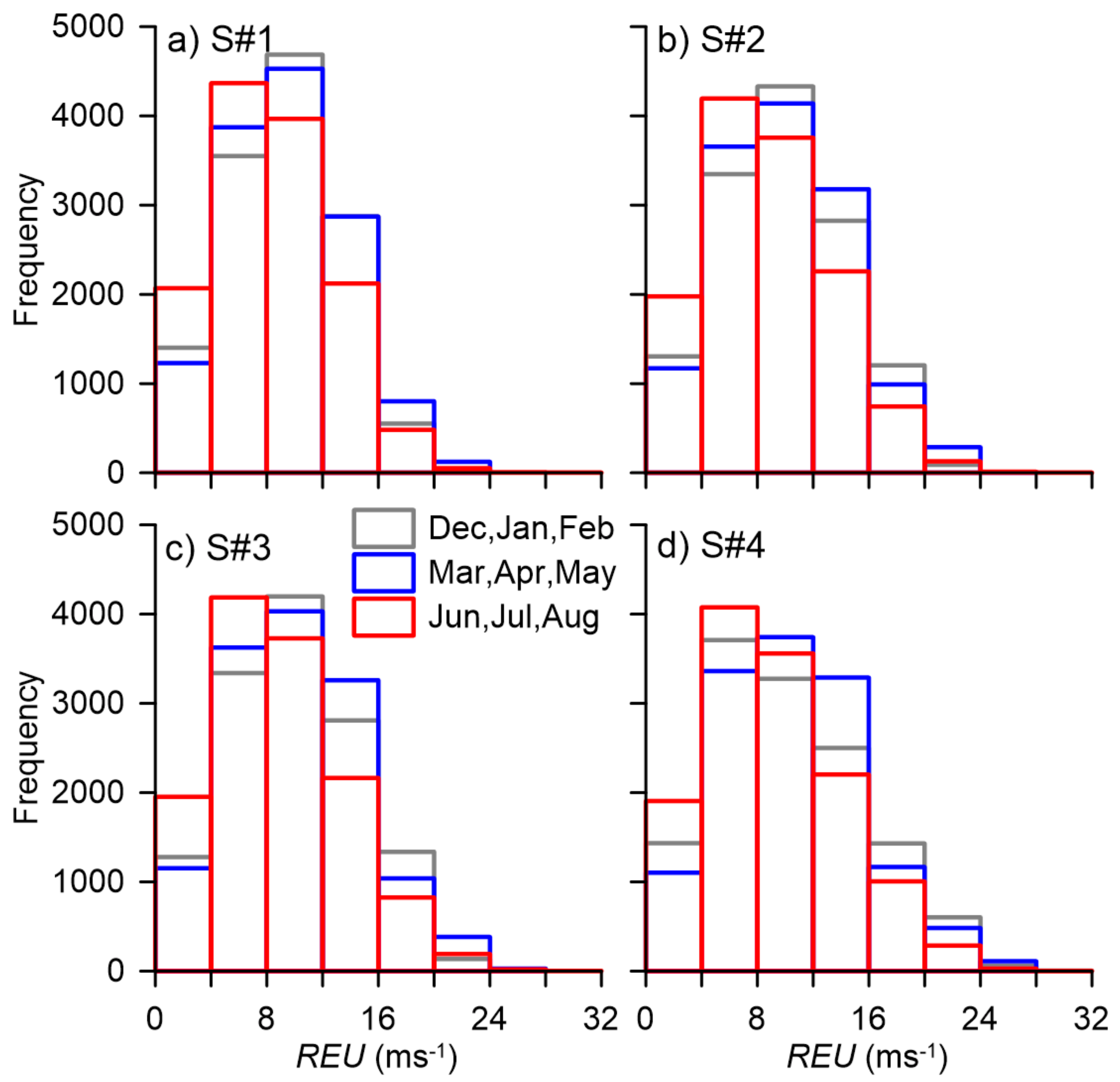
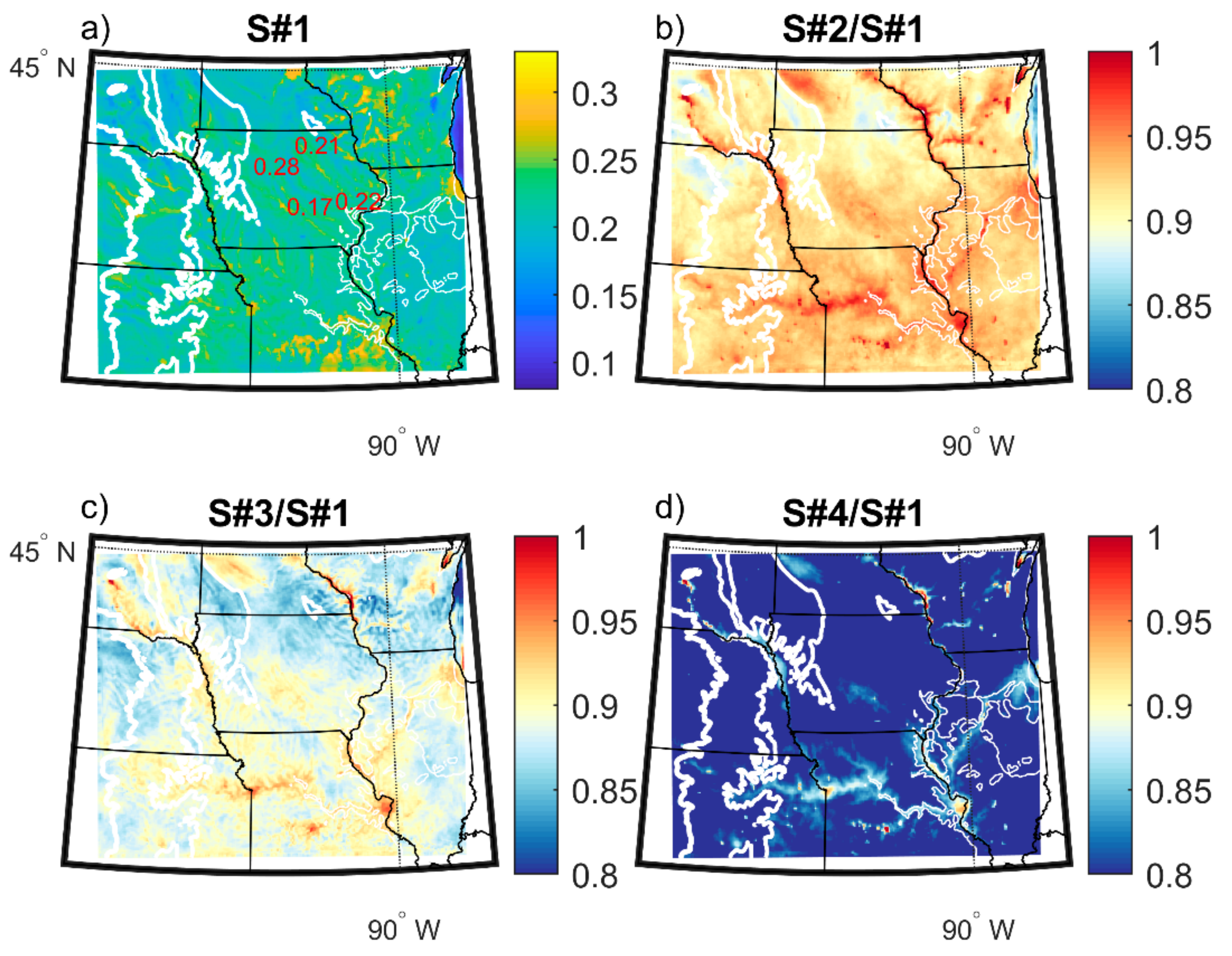
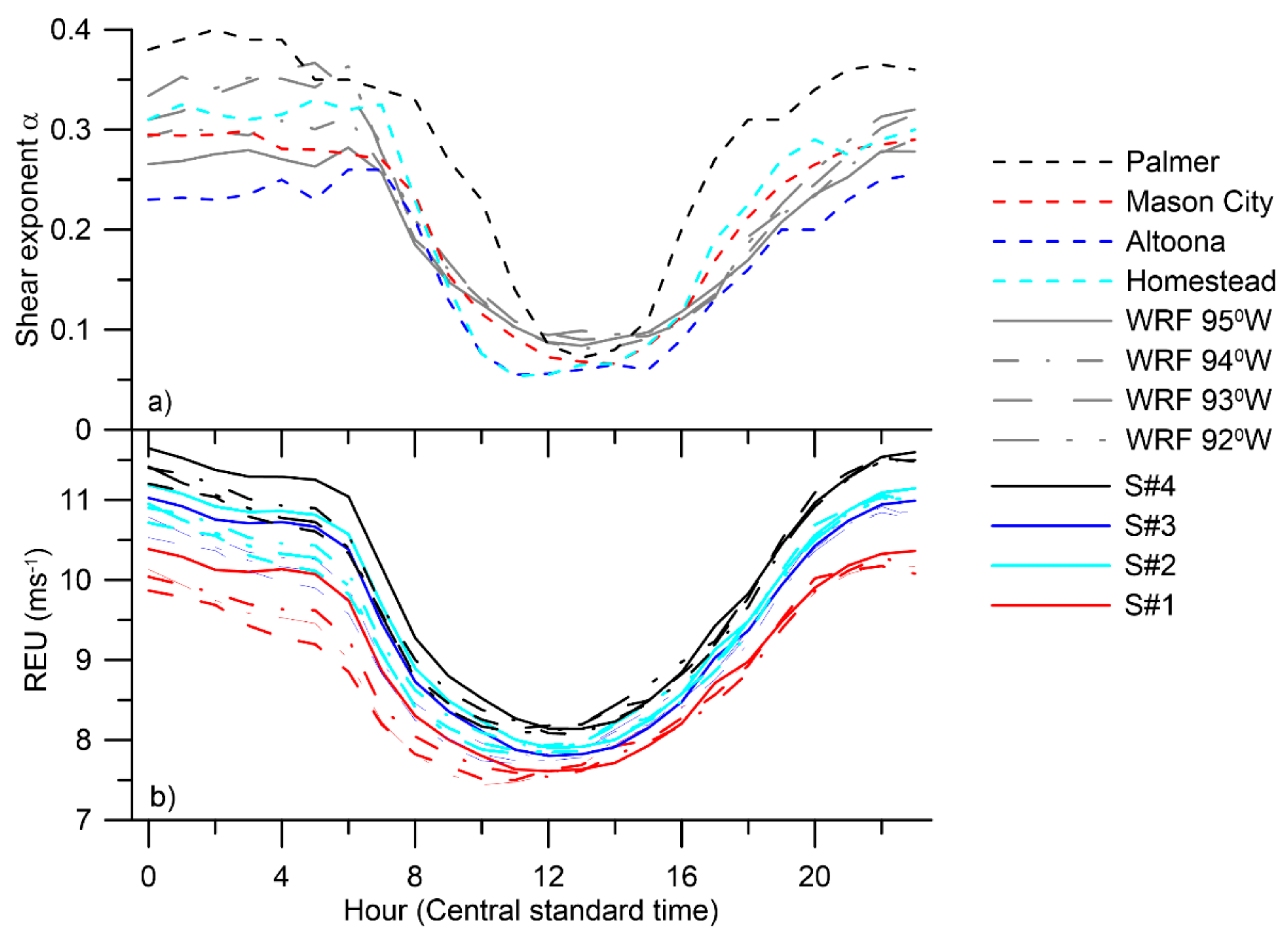
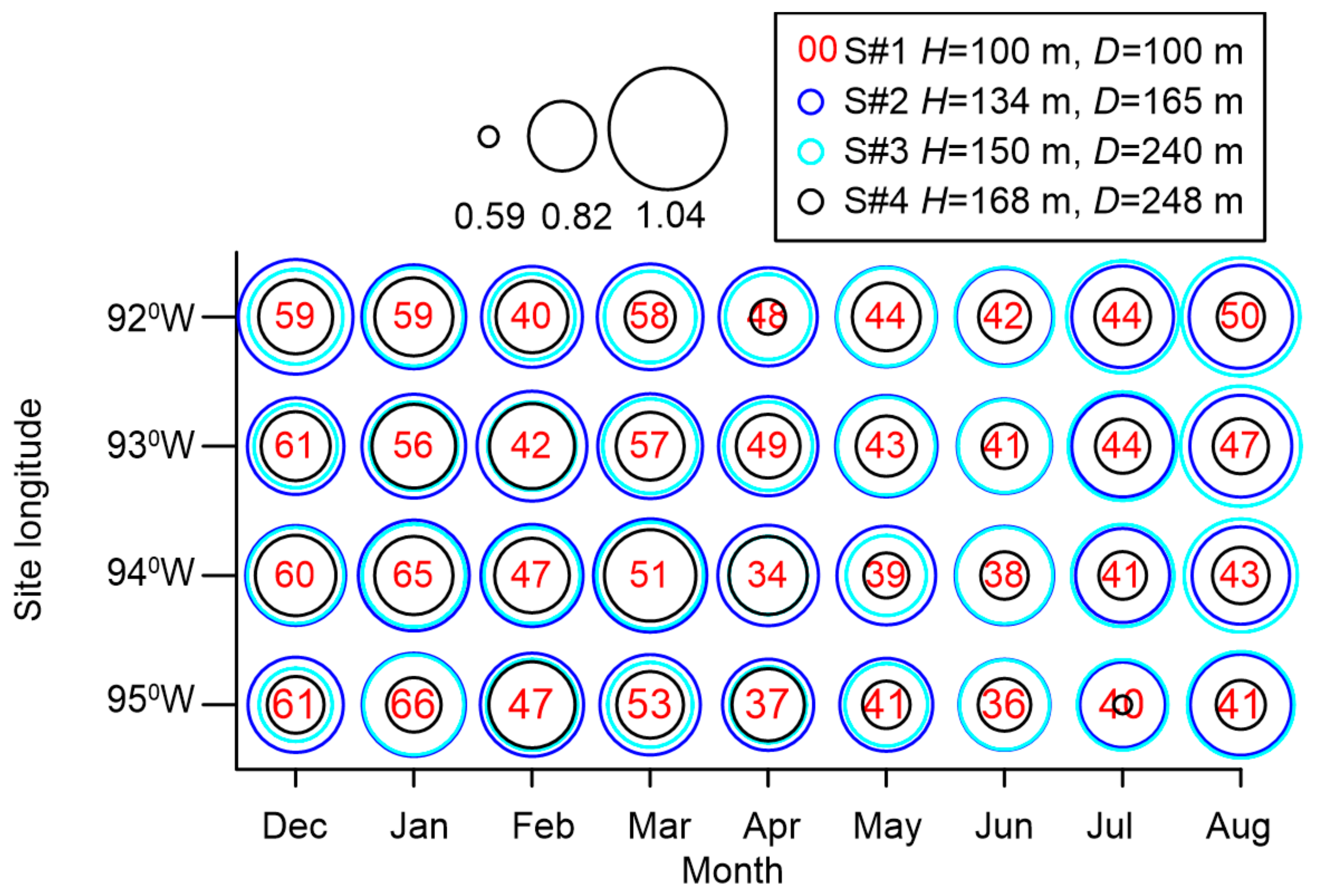
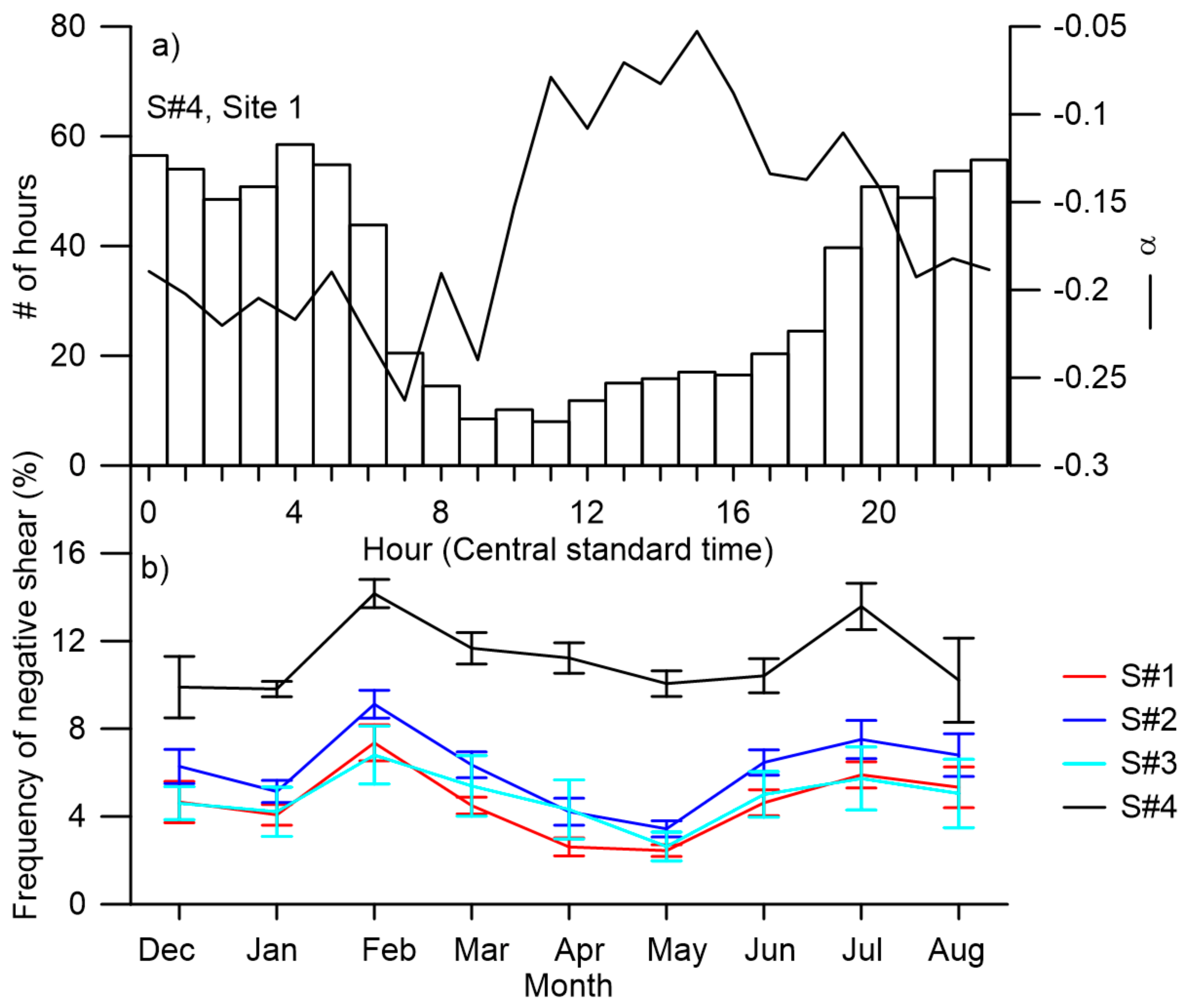
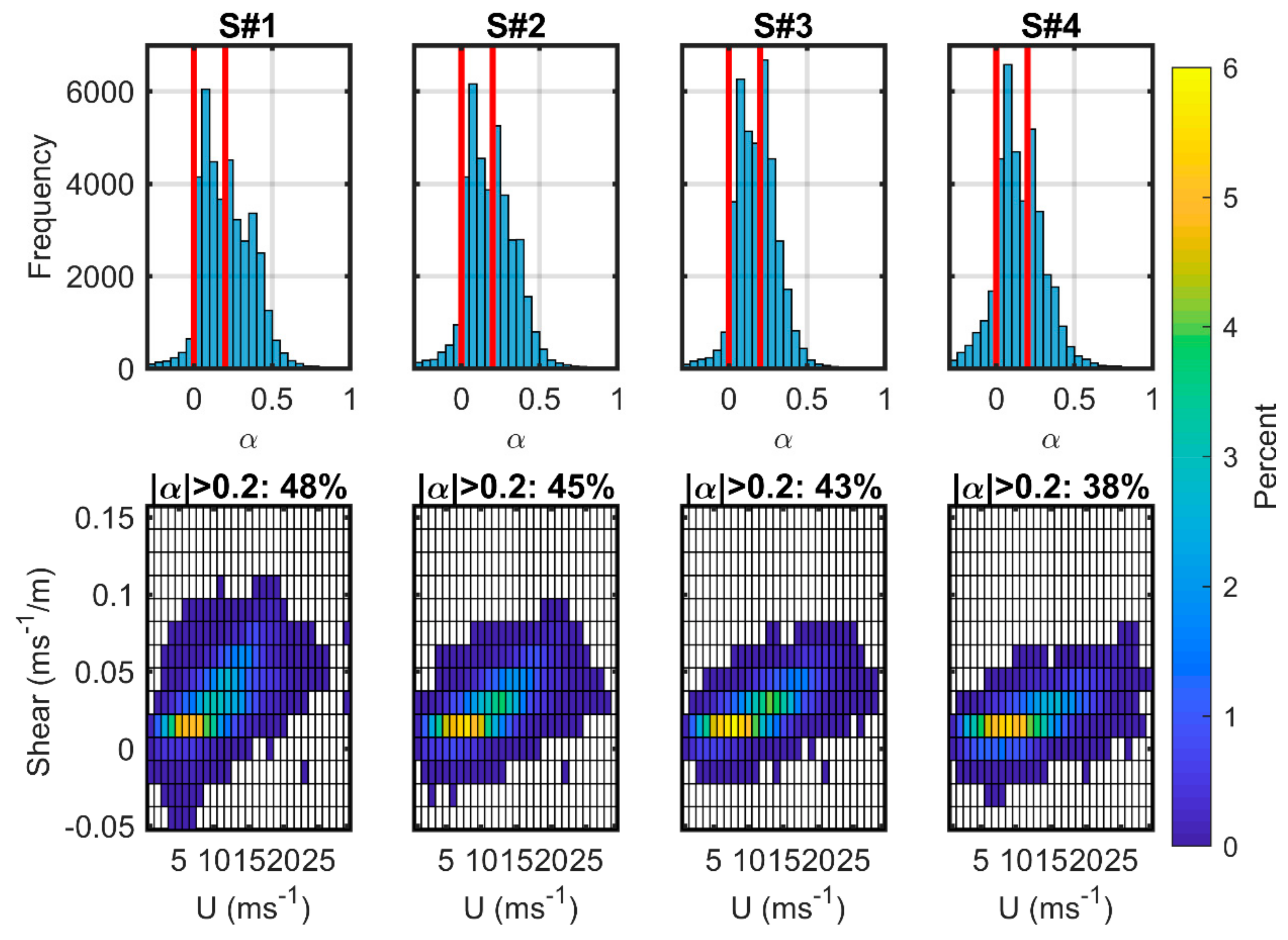
| Scenarios | Median REU (ms−1) | ||||||
| H (m) | D (m) | Rotor Tip Height (m) | Location 1: 43° N, 95° W | Location 2: 43° N, 94° W | Location 3: 43° N, 93° W | Location 4: 43° N, 92° W | |
| S#1 | 100 | 100 | 150 | 8.95 | 8.61 | 8.53 | 8.54 |
| S#2 | 134 | 165 | 217 | 9.31 | 8.98 | 8.87 | 8.93 |
| S#3 | 150 | 240 | 270 | 9.38 | 9.07 | 8.95 | 9.01 |
| S#4 | 168 | 248 | 292 | 9.60 | 9.40 | 9.24 | 9.29 |
| Median U at Hub-Height (ms−1) | |||||||
| H (m) | D (m) | Rotor tip height (m) | Location 1: 43° N, 95° W | Location 2: 43° N, 94° W | Location 3: 43° N, 93° W | Location 4: 43° N, 92° W | |
| S#1 | 100 | 100 | 150 | 8.84 | 8.50 | 8.41 | 8.43 |
| S#2 | 134 | 165 | 217 | 9.30 | 8.98 | 8.87 | 8.94 |
| S#3 | 150 | 240 | 270 | 9.46 | 9.14 | 9.04 | 9.12 |
| S#4 | 168 | 248 | 292 | 9.71 | 9.42 | 9.26 | 9.34 |
| Scenario | Location 1: 43° N 95° W | Location 2: 43° N 94° W | Location 3: 43° N 93° W | Location 4: 43° N 92° W |
|---|---|---|---|---|
| S#1 | 1 | 1 | 1 | 1 |
| S#2 | 3.300 ± 0.070 | 3.299 ± 0.074 | 3.299 ± 0.069 | 3.286 ± 0.054 |
| S#3 | 7.078 ± 0.213 | 7.093 ± 0.210 | 7.096 ± 0.200 | 7.040 ± 0.157 |
| S#4 | 8.729 ± 0.361 | 8.774 ± 0.367 | 8.771 ± 0.339 | 8.661 ± 0.259 |
| P (106 W) | Spatial Mean α for Each of the WT Scenarios | |||||||
|---|---|---|---|---|---|---|---|---|
| S#1 | S#2 | S#3 | S#4 | S#1 | S#2 | S#3 | S#4 | |
| December | 5.41 | 17.94 | 38.63 | 47.90 | 0.245 | 0.228 | 0.219 | 0.196 |
| January | 7.99 | 26.94 | 58.62 | 73.32 | 0.246 | 0.233 | 0.223 | 0.209 |
| February | 6.24 | 20.30 | 43.58 | 53.44 | 0.206 | 0.192 | 0.187 | 0.168 |
| March | 5.43 | 18.17 | 39.46 | 49.20 | 0.201 | 0.186 | 0.178 | 0.156 |
| April | 8.61 | 28.31 | 61.12 | 75.64 | 0.199 | 0.185 | 0.177 | 0.157 |
| May | 6.04 | 19.37 | 41.34 | 50.41 | 0.202 | 0.186 | 0.179 | 0.155 |
| June | 5.90 | 18.92 | 40.23 | 49.09 | 0.201 | 0.183 | 0.179 | 0.149 |
| July | 3.99 | 13.17 | 27.84 | 34.03 | 0.210 | 0.189 | 0.182 | 0.148 |
| August | 4.47 | 15.04 | 32.17 | 39.87 | 0.223 | 0.201 | 0.192 | 0.154 |
| WT Scenario | H (m) | D (m) | Rotor Tip Height (m) | Frequency of LLJ within the Rotor Plane (%) | |||
|---|---|---|---|---|---|---|---|
| Location 1: 43° N 95° W | Location 2: 43° N 94° W | Location 3: 43° N 93° W | Location 4: 43° N 92° W | ||||
| S#1 | 100 | 100 | 150 | 9.0 | 9.0 | 8.2 | 7.7 |
| S#2 | 134 | 165 | 217 | 14.9 | 14.2 | 13.2 | 14.0 |
| S#3 | 150 | 240 | 270 | 18.5 | 17.5 | 16.3 | 17.2 |
| S#4 | 168 | 248 | 292 | 19.2 | 18.7 | 17.3 | 18.2 |
| Mean LLJ height (m) | 182 | 186 | 187 | 189 | |||
© 2020 by the authors. Licensee MDPI, Basel, Switzerland. This article is an open access article distributed under the terms and conditions of the Creative Commons Attribution (CC BY) license (http://creativecommons.org/licenses/by/4.0/).
Share and Cite
Barthelmie, R.J.; Shepherd, T.J.; Aird, J.A.; Pryor, S.C. Power and Wind Shear Implications of Large Wind Turbine Scenarios in the US Central Plains. Energies 2020, 13, 4269. https://doi.org/10.3390/en13164269
Barthelmie RJ, Shepherd TJ, Aird JA, Pryor SC. Power and Wind Shear Implications of Large Wind Turbine Scenarios in the US Central Plains. Energies. 2020; 13(16):4269. https://doi.org/10.3390/en13164269
Chicago/Turabian StyleBarthelmie, Rebecca J., Tristan J. Shepherd, Jeanie A. Aird, and Sara C. Pryor. 2020. "Power and Wind Shear Implications of Large Wind Turbine Scenarios in the US Central Plains" Energies 13, no. 16: 4269. https://doi.org/10.3390/en13164269
APA StyleBarthelmie, R. J., Shepherd, T. J., Aird, J. A., & Pryor, S. C. (2020). Power and Wind Shear Implications of Large Wind Turbine Scenarios in the US Central Plains. Energies, 13(16), 4269. https://doi.org/10.3390/en13164269





